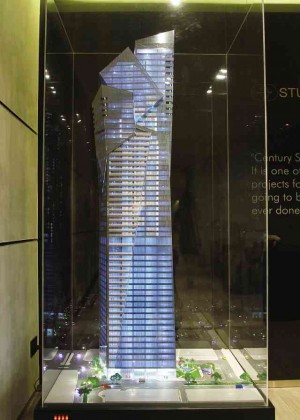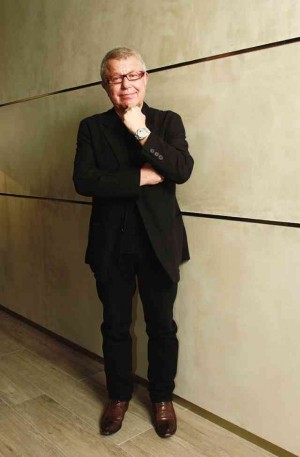
It takes only a statement project to spark interest in the gentrification of a degenerating city.
Daniel Libeskind, dubbed by the New York Times as a “starchitect,” could have been describing the redevelopment of the World Trade Center, of which he was the master planner. But he was actually referring to his Philippine project, the mixed-use high-rise Century Spire.
Libeskind recently came to Manila for the groundbreaking rites and to meet the foreign and local press. In an interview with Inquirer Lifestyle, he said the transformation of a metropolis begins with small things. “Most people think of how to improve the city overall. A city can change dramatically with the right building and the right developer. It can change the way people will look at the city. When Picasso painted the famous portrait of Gertrude Stein, she commented, ‘It’s a nice portrait, but it doesn’t look like me.’ Picasso answered, ‘Don’t worry, it will.’ That’s the future. That’s how cities change,” explained Libeskind.
The 60-story Century Spire is the latest project that was launched at Century City, a master-planned, mixed-use community along Kalayaan Avenue, Makati. Located at the former grounds of the International School of Manila, this community hosts the country’s tallest building, the 302-meter, 72-story Gramercy Residences, and new Century City Mall.
Likewise there’s the 220-meter, 64-story Knightsbridge Residences, which will be the country’s fifth tallest building upon completion. Also on the rise are branded projects such as Milano with the Versace Home, Trump Tower, Forbes office tower, and Centuria Medical Makati, a high-tech healthcare facility.
Targeted for 2018, Century Spire will provide 500 spacious and state-of-the-art residential units, and office spaces. The crown of the building will contain lifestyle amenities.
“It’s like a microcosm of a city,” said Libeskind.
Youthfulness
At P250,000 per sq m (for units ranging from 30-400 sq m), the price is scaled for the upmarket. Suites cost from P8 million to P11 million, while the large two-bedroom units at the crown fetch P100 million. These prices are said to be a fraction of the real-estate prices in Singapore and Hong Kong. The projected sales revenue is P8.4 billion. At this writing, 67 percent of the units have been sold.
While many vertical developments resemble boxes, Century Spire is distinguished by its narrower base to make room for a landscaped plaza; while at the top floors, it feathers out into three shafts, like a flower in bloom.

“It’s a landscape of buildings, not just a building that is cut or projected into an antenna. The crown was developed organically from the shape of the building. It wasn’t plopped on top of it from some other vocabulary,” Libeskind pointed out. “Up there, you see a world, a microcosm. You’re not looking at a technical solution but a sculpture. When you look up, there’s something to captivate the imagination.
“The head of a building is important because it shows its profile to the city. When you stand there, you will feel something intimate. You’re not next to a big piece of equipment, but next to a building that has a character.”
Although Libeskind is famous for his radical designs, he modestly denied being an iconoclast. “It’s just a matter of being creative. Buildings need to speak to people. Most 10-year-olds will not even notice buildings. But with Century Spire, looking up is one of the most interesting things. It communicates something important in Manila.”
The design reflects the youthfulness of the Philippines, he said. “Every building should have emotions. This is an optimistic statement that looks toward something new,” he said.
Robbie Antonio, executive vice president and the head of business development of Century Properties, the developer of Century City, said the company’s encounters with Libeskind have enlightened them about architecture as an art.
“We don’t want to just show what is beautiful, but also show our country’s progress. In our small way, development is our contribution,” he said.
Antonio added that the three sculpted shafts at the crown, which resemble flowering petals, represent the collaboration of Century Properties, Armani/Casa Armani Interiors and Studio Daniel Libeskind. G.F. & Partners Architects is the local counterpart.
Green building design

Libeskind described that the building’s support structure will be clad with a curtain wall, the outer skin which not only lends class but also buffers noise and temperature and keeps the building stable during strong winds and earthquakes.
As in most contemporary buildings, it will adapt environment-friendly elements such as low-emissivity windows to insulate the heat, prodigious use of locally available materials, distribution of air cooling condensers (instead of centralized cooling), low-energy lighting systems and water recycling.
“The building has to be sustainable by using these materials in smart ways. It needs smart technology to allow the building to function and breathe with the lowest possible carbon footprint,” said Libeskind. “Architecture can no longer be an anonymous bunch of extrusions from the ground. It should be sustainable. We can’t abuse nature and use scarce resources resourcefully. Using them carefully and creatively is the way of the future.”
The construction cost is estimated at P4.7 billion, including Armani/Casa services. Asked what he would have done if given an unlimited budget, Libeskind replied, “I never liked projects that seemed to have unlimited resources. They become follies. Good projects are always a tension within the frame with which they are built. It’s not just the frame of money but also social, economical and practical. That is what makes architecture interesting. Without it, there is only entertainment.”
Robbie and his father, Jose E.B. Antonio, chair of Century Properties, were attracted to the way Libeskind imbued emotional resonance in his works. While touring Berlin, the older Antonio was impressed with Libeskind’s milestone project, the Jewish Museum. It consists of three underground tunnels that symbolize the link between the harsh realities of Jewish life in Nazi Germany. He recalled the stirring atmosphere of the Holocaust Tower, which is emphasized by the bare concrete and the small slit on the roof which provides light and air.
Likewise, when Robbie was working in New York, he was amazed at how the World Trade Center (WTC) rose from the rubble after 9/11.
Studio Daniel Libeskind moved from Berlin to New York when he won the invitational competition to develop a plan for the WTC’s redevelopment in 2002.
Both the Berlin Museum and the WTC project took over a decade to complete due to politics and divergent opinions of his clients. Citing the WTC redevelopment in Lower Manhattan as the most difficult project in the world, he explained, “Look at the stakeholders—thousands of members of families whose relatives, nearly 3,000, perished in the 9/11 attacks.
Different ideas
“There was the Port Authority of New York and New Jersey that owns the land and leases the land to private developers with their own architects; the governor of New York and New Jersey; the mayor who is in charge with streets of New York; the Metropolitan Transit Authority for the subway and the path trains that run under the ground. That’s a small picture of how complex and how many different ideas they have.
“To create a master plan, you have to create a consensus. But the parties have different desires and agendas. The master plan was to build something memorable—not just looking backwards, but creating 21st century New York in terms of public space, culture, connectivity of streets, both horizontally and vertically,” Libeskind said.
As in many projects, an architect’s initial ideas don’t always become realities. After many changes in the design of the One World Trade Center tower, only one element from Libeskind’s original concept remained—that of establishing a dramatic scale to create awe.
One World Trade Center, with its sky-piercing spire, stands 541 meters, making it the second tallest building in the West.
Despite the challenges, Libeskind managed to convince everybody to consider Ground Zero a sacred site, not just a piece of real estate. As a result, half of the property is devoted to open space, a generous offering of the city.
“I was the only architect who did not build where the towers once stood. The other finalist architects proposed tall buildings. I felt it should be a memorable space that goes down to the bedrock with all the slurry walls and memory. Out of it should rise not one building but mega structures. Now we have four towers, better streetscapes and out of 16 acres (6.5 hectares), eight acres (3.2 ha) are public spaces,” he said.
“Some 60,000 people have moved to Lower Manhattan as a result of this rebuilding. When I first came to Manhattan, the offices were abandoned. They looked like Pompeii. Now office buildings are being transformed into apartment buildings, and new schools have come up. Lower Manhattan is experiencing a renaissance. When the project has the right optimism, the right memory and speaks to the human heart, people get it. You need patience. I learned that from my project with the Jewish Museum which took 12 years to build. In New York, this took more than a decade. But this is what it takes to make a project meaningful,” he added.
After hurdling difficult clients, Libeskind said working with Century Properties has been productive. “Every building depends on the vision of the client. I’ve been lucky working with Ambassador (Joey Antonio) and Robbie. They love architecture and Manila. That makes the project come alive. These clients think out of the box. They’re not just repeating a building from somewhere else. It’s part of a hub of high energy, aspirational buildings in Century City. Not every client thinks like this,” said Libeskind.
In the end, developers play a vital role in contributing to urban renewal, he said. “We don’t judge the city by the museum, church or public building. The ultimate judgement is how well people live. I think that raising the bar, as Century Spire does, is part of the competitiveness. Cities have to regenerate their spirit and substance in terms of what they have to offer in the market.”













































